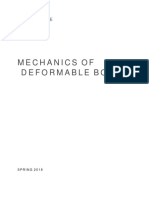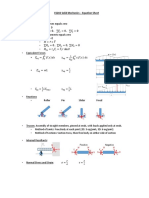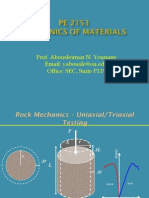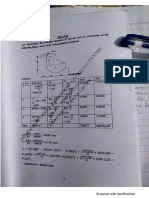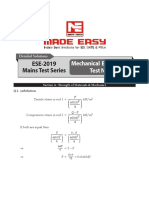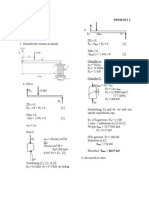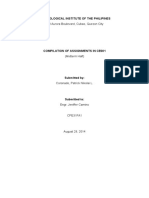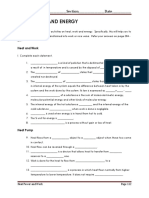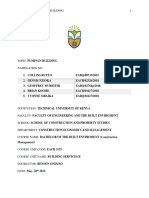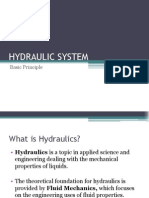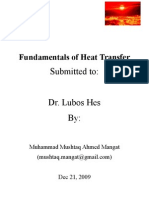EGR 236 Properties and Mechanics of Materials Lecture 26: Combined Loadings
Spring 2012
Today: -- Homework questions: -- New Topics: -- Combination Stress Loading -- Homework: Read Section 8:2 Work Problems from Chap 8: 15, 20, 36, 56 Following today's class you should be able to: -- show how many types of stress can contribute the total stress state of a body. -- be able to calculate the stress load of each kind of stress and combine these by superposition on the same body. Review: So far you have learned how to calculate the stress state due to the following internal reactions: Axial Force: P A = A Torsion:
P P A
T T = J
Bending:
M =
Mc I
V
Transverse Shear
V =
VQ It Pd 2t Pd 4t
Internal Pressure:
hoop =
axial =
h a h
a a a a a
�Example 1: The beam supports the loading shown. Determine the state of stress at points E and F at section a-a and represent the results on a volume element located at each of the points.
Solution: Step 1: Find external support reactions: M = 0
FCy 1m FCx 20 kN T 3m 39.5
o
0 = 20kN * 1m + T sin 395 . * 4m T = 7.86 kN
o
Fx = 0 0 = FCx T cos 395 . o FCx = 6.06 kN
Fy = 0 0 = FCy 20kN + T sin 395 . o FCy = 15 kN
Next find internal shear , normal, and moment acting at section a-a
M = 0 0 = 15kN * 1m + 10kN * 05 . m+M M = 10 kN m Fy = 0 Fx = 0 0 = 6.06 + N 0 = 15 10 V N = 6.06 kN V = 5 kN
15kN 10kN/m M N 6 kN 1m V
�Next Calculate stress for each type of load: Axial Load: P A = A where P = N = -6.06 kN and area is
= 6000 mm2
A = 10mm * 150mm + 15mm * 200mm + 10mm * 150mm
2
P 6.06kN 1000mm 1000N A = = = 1.010 x106 N / m2 2 A 6000mm 1m kN This applies to both points E and F.
Torsional Load: Does not apply to this case. Bending Load:
M =
Mc I
where M = 10kn-m cE = 0 and cF = 110 mm = +0.110 m
I = I1 + I 2 + I3
I1 =
1 3 1 bh + Ad 2 = ( 150 )( 10 )3 + ( 10* 150 )( 105 )2 = 16550000mm 4 12 12 1 3 1 I2 = bh + Ad 2 = ( 15 )( 200 )3 + ( 15* 250 )( 0 )2 = 10000000mm 4 12 12 I3 = I1 = 16550000mm 4
so I = I1 + I2 + I3 = 2* 16550000mm 4 + 100000000mm 4 = 43100000mm4 then 4 Mc ( 10kN m )( 0110 . m ) 1000mm 1000 N M _ at _ F = = * = 2552 . x106 N / m2 4 I 43100000mm 1m 1kN Mc ( 10kN m )( 0 ) M _ at _ E = = =0 (compression) I 43100000mm4 Transverse Shear Load:
�V =
VQ It
where V = 5 kN I = 43100000 mm4 tE = 15 mm tF = 10mm QF = 0 QE = (10*150)(105)+(15*100)(50)= 232500mm3 then
2
V _ at _ E
VQ ( 5kN )( 232500mm3 ) 1000mm 1000 N = = = 1798 . x106 N / m2 6 4 It ( 431 . x10 mm )( 15mm ) 1m 1kN
V _ at _ F =
VQ ( 5kN )( 0 ) = =0 It ( 431 . x106 mm4 )( 10mm )
Internal Pressure: Does not apply to this problem Therefore drawing the stress elements at F and E: At element F:
F M = 25.5 MPa A =1.01 MPa F F = 26.5MPa
At element E:
V = 1.798 MPa E A =1.01 MPa
Example 2:
�A uniform sign has a weight of 1500 lb and is supported by the pipe AB, which has an inner radius of 2.75 in and an outer radius of 3 in . If the face of the sign is subjected to a uniform wind pressure of p = 150 psf, determine the state of stress at points C and D. Show the results on a differential element located at each of these points. Neglect the thickness of the sign and assume that it is supported along the outside edge of the pipe. ____________________________________________________________ Assume elements are on the outer surface of the post. Step 1) internal loads at section
W= 1500 lb Fwind = 12ft*6ft*150lb/ft2 =10800 lb W
For Equilibrium:
r F = 0 r r r 0 = W + Fwind + FA F 0 = Wk wind j + FAx i + FAy j + FAz k
j: 0 = 10800lb + FAy
Fwind
so i: 0 = FAx
FAx = 0
k:
FAy = 10800lb
MAx
FAx
0 = 1500lb + FAz FAz = 1500lb
MAy FAz FAy
r M = 0 r r r 0 = M A + rG / A FG r r r r r +r 0 = M Ax i + M Ay j + M Az k F + r W + r F A/ A A G/ A G/ A wind
MAz
+ 0 + ( 6 ) ( 1500k ) + ( 6 ) ( 10800 j ) 0 = M Ax i + M Ay j + M Az k i + 6k i + 6k 9000 + 64800 0=M i+M j+M k j + 64800k i
Ax Ay Az
so i: 0 = M Ax + 64800
j: 0 = M Ay 9000
k: 0 = M Az + 64800
M Ax = 64800 l b ft
M Ay = 9000 l b ft
M Az = 64800 l b ft
Step2: Consider individual load stresses:
�Axial Force: P A = A Axial Force: P A = A and Therefore:
Torsion: T T = J where
A=
Bending:
Transverse Shear
M =
Mc I
V =
VQ It
P = FAz = 1500 lb (in compression)
Do2 Di2 ) = ( R2 r 2 ) = ( 32 275 . 2 ) = 4516 . in2 ( 4
A =
Torsion: T T = J
P 1500lb = = 332.1psi A 4.516in2
where
and
T = MAz = -64800 lb-ft
= Ro = 3in J = ( Ro2 RI 2 ) = ( 34 275 . 4 ) = 37.4in 4 2 2 ( 64800lb ft )( 3in ) 12in = = 62374 psi 37.4in4 1 ft
and about y-axis
Bending: About x-axis
M _C =
where and
M xcy Iy
M _ about _ y axis =
M y cx Ix
Mx = -64800 lb-ft cx = cy = 3 in
My = 9000 lb-ft
Ix = Iy =
Therefore:
4 Ro Ri4 ) = ( 34 275 . 4 ) = 187 . in 4 ( 4 4
M _ about _ x axis = M _ about _ y axis
( 64800lb ft )( 3in ) 12in = 124748 psi (Tension) 187 . in4 1 ft ( 9000lb ft )( 3in ) 12in = = 17326 psi (Tension) 187 . in 4 1 ft
Transverse Shear:
�V =
And
VQ It
with V = FAy=10800 lb
t = 2(3-2.75)= 0.5 in
FAy C
I = 187 . in 4
4 Ro 4R ) ( Ri2 )( i ) 3 3 4* 3 4* 275 . = ( 32 )( ) ( 275 . 2 )( ) = 827 . in3 3 3 QD = 0 QC = ( Ro2 )(
Therefore
V _ at _ C
V _ at _ D
VQ ( 10800lb )( 827 . in3 ) = = = 9553 psi It ( 187 . in 4 )( 05 . in )It VQ = =0 It
Combination Infinitesimal Elements:
17326 psi (bending) 321 psi (axial) 62347 psi (axial) 9553 psi (shear) C 321 psi (axial) 62347 psi (torsion) D 124748 psi (bending)
Example 3:
�Complete the following Workout Problem working together with a partner. When completed, check your answer against the instructor's solution. The 3/4 in diameter shaft is subjected to the loading shown. Determine the stress components at point A and B. Sketch the results on a volume element located at these points. The bushing at C can only supply force components along the y and z direction. The bushing at C is also keyed so that it restrains rotation about the x axis, but not the y or z. The thrust bearing at D can supply force components along all three directions. It does not supply any restraint of rotation.
100 lb
50 lb
B FDz
Start by finding the support reactions:
100 lb FDx FDy
50 lb
FCz
MCx For Equilibrium:
FCy
�r F = 0 50k +F 0 = 100k Cy j + FCz k + FDx i + FDy j + FDz k
so i: j: k:
FDx = 0 FCy + FDy = 0 FCz + FDz = 150
r M = 0 r r r r r r r )+ r )+ r 0 = M C + rC / C FC + r100 / C ( 100k ( 50 k F 50 / C D/C D r ) + ( 22 ) 0 = M Cx i + 0 FC + ( 18 i 8 j ) ( 100k i + 8 j ) ( 50k ) + ( 40 i ) ( FDx i + FDy j + FDz k
+ 40 F 0 = M Cx i 1800 j + 800 i 1100 j 400 i + 40 FDy k Dz j
i: j: k:
0 = M Cx + 800 400 0 = 1800 1100 + 40 FDz 0 = 40 FDy
FCy + FDy = 0
M Cx = 400 lb in FDz = 725 . lb FDy = 0
therefore from :
FCy = FDy = 0
FCz + FDz = 150
FCz = FDz + 150 = 725 . + 150 = 775 . lb
FDz=72.5 lb
100 lb 50 lb
FCz= 77.5 lb
Now look the internal M at= -400 lb-in reactions at the cross section of interest:
Cx
�For Equilibrium:
r F = 0 N 0 = 775 . k x i + V y j + Vz k Nx = 0 Vy = 0 Vz = 775 . lb
FCz= 77.5 lb
Mz Vz Tx Nx Vy My
so i: j: k:
r M sect = 0
MCx = -400 lb-in
+ 0( N 0 = 400 i + 10 i 775 . k x i + V y j + Vz k ) + ( Txi + M y j + M z k ) 0 = 400 i 775 j T i +M j+M k
x y z
i: j: k:
0 = 400 Tx 0 = M y 775 0 = Mz Nx = 0 : Tx = 400 lb in
Tx = 400 lb in M y = 775 lb in Mz = 0 Vz = 775 . lb Mz = 0
therefore internal reactions are
Vy = 0
M y = 775 lb in
Next find any of the stresses associated with each of these.
Axial Force: P A = A Transverse Shear
Torsion: T T = J
Bending:
M =
Internal Pressure:
Mc I Pd 4t
V =
VQ It
hoop =
Pd 2t
or
axial =
Axial Stress:
since N=0
Ax = 0
�Torsional Stress: where and
T J T = Tx = -400 lb-in
T =
= d / 2 = 0.75 / 2 = 0375 . in 4 J = R2 = d = 075 . 4 = 0.03106 in 4 2 32 32 T ( 400lb in )( 0375 . in ) T = = = 4829 psi J 0.03106in 4
Bending Stress: about z-axis
since Mz = 0 then
Mz _ A = Mz _ B = 0
about y-axis
M z = 775 lb in
for point A: for point B: cA = 0.375 in cB = 0.0 in
Iy =
Therefore:
4 4 R = d = 075 . 4 = 0.01582 in 4 4 64 64
( compression )
My _ A =
( 775lb in )( 0375 . in ) = 18371 psi 0.01582in 4
My _ B = 0
. lb and QA = 0 Transverse Shear : since Vz = 775
�for point A: for point B:
Vz _ A =
VQ =0 It
t = d = 0.75 in
d 2 4R d d 3 075 . 3 % QB = Ay = = = = 0527 . in3 * 8 8 3 2 R 8
I = 0.01582 in 4
Vz _ B
VQ ( 775 . lb)(0527 . in3 ) = = = 3442 psi It (0.01582in 4 )(075 . in)
does not apply to this problem not a pressurized tank.
Internal Pressure:
Summary of stress on A: Torsion: T = 4829 psi Bending : My _ A = 18371 psi ( compressive along x axis )
Summary of stress on B: Torsion: T = 4829 psi Transverse Shear: Vz _ B = 3442 psi
Therefore the combined stress models look like:
�z My T A
T B
Vz y
z x
A A x T
My x
B T Vz
= 4829 psi = 18 371 psi A B
= 1387 psi EGR 236 Mechanics of Materials Problem 8:15 HW Set 26 Spring 2012
�Determine the magnitude of the load P that will cause a maximum normal stress of 200 MPa in the link. -----------------------------------------------------------------------------------------------------------
�EGR 236 Mechanics of Materials Problem 8:20
HW Set 26
Spring 2012
The joint is subjected to a force of 250 lb as shown. Sketch the normal stress distribution acting over section a-a if the member has a rectangular cross section of width 0.75 in and thickness 0.5 in. ____________________________________________________________________ Solution:
�EGR 236 Mechanics of Materials Problem 8:36
HW Set 26
Spring 2012
The frame supports a centrally applied distributed load of 1.8 kip/ft. Determine the state of stress at points A and B on member CD and indicate the results on a volume element located at each of these points. The pins at C and D are at the same location as the neutral axis for the cross section. ____________________________________________________________________ Solution:
1.8 kip/ft
�EGR 236 Mechanics of Materials Problem 8:56
HW Set 26
Spring 2012
The 1 in diameter rod is subjected to the loads shown. Determine the state of stress at point B, and show the results on a differential element located at this point. ____________________________________________________________________ Solution:






